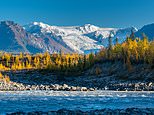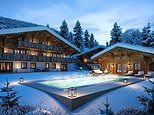
America’s largest national park covers more than 13 million acres and boasts stunning Alpine scenery paired with a storied history.
Still, many don’t even know it exists.
Alaska’s Wrangell-St. Elias National Park and Preserve lies in the southern part of the state, featuring around 13.2 million acres of snow-topped mountains, thousands of glaciers and gorgeous wilderness.
Despite the park’s plethora of breathtaking views, wildlife and rich background, its remote location makes accessing it difficult.
With only around 80,000 annual visitors, the park’s beauty often goes unnoticed.
Its picturesque landscape was carved by powerful geological forces that drove the collision of crustal plates, according to the National Park Service.
The park’s mountain ranges include the Wrangell, the St. Elias and the Chugach, which overlook vast landscape and reflect off of blue glacial waters.
Four major mountain ranges meet in the park, with nine of their peaks among the 16 tallest in the United States, the NPS said.
Wrangell-St. Elias National Park and Preserve lies in the south of Alaska, consisting of around 13.2 million acres of snow-topped mountains, thousands of glaciers and gorgeous wilderness
Despite the park’s plethora of breathtaking views, its remote location makes accessing it difficult. With only around 80,000 annual visitors, the park’s beauty often goes unnoticed
Cushioning the base of the park’s mountains are rivers of glacial waters
The Wrangell Mountains are volcanic in origin, but Mount Wrangell, at 14,163 feet, is the only remaining active peak. Its last eruption was reported in the 1900s and steam can be seen rising from its summit.
Cushioning the base of the mountains are rivers of glacial water, reflecting a stunning turquoise color. The largest is the Copper River in the west of the park, which empties into the Gulf of Alaska in the Chugach National Forest.
The Malaspina glacier is one of the most impressive in the park and flows out of the St. Elias Range between Icy and Yakutat bays in a mass larger than Rhode Island.
Rushing through the park’s rivers and streams are famously well-kept salmon, which are carefully monitored to allow for plentiful reproduction.
The Copper River is home to steelhead and rainbow trout, while the Yukon River, which empties into the Bering Sea, is home to schools of northern pike.
Being the largest of America’s national parks, Wrangell-St. Elias also includes part of one of largest ecosystems in the world – the boreal forest.
The forest spans over 20,000 square miles and consists of mixed spruce, aspen and balsam poplar. Its alpine meadows, alder and willow thickets, shorelines, glacial barrens and icefields make for a rich habitat for wildlife.
Many species of birds, including redpolls, pine grosbeaks and foraging chickadees, call the park home. So do three species of North American bears: Grizzly bears, Black bears and polar bears.
Four major mountain ranges meet in the park, with nine of their peaks among the 16 tallest in the United States
The Malaspina glacier (pictured) is one of the most impressive of the park, and flows out of the St. Elias Range between Icy and Yakutat bays in a mass larger than Rhode Island
The boreal forest spans over 20,000 square miles and consists of mixed spruce, aspen and balsam poplar
The park is host to many mammals, including bison, mountain goats, pumas, cougars, mountain lions, deer, coyotes, wolves, lynx, wolverine and mink.
Its waters contain otters, many species of seals and whales, including belugas, killer whales and humpback whales.
The National Park Service says visitors have a better chance to catch a glimpse of wildlife through binoculars and urges passersby to make frequent stops to view from a distance.
Cabins dot the park, and most are former mining, trapping or hunting lodges on public lands.
Many cabins are first-come, first-serve and are only accessible by flying into remote areas, according to the NPS. Only four cabins in the park – Viking Lodge, Caribou Creek, Nugget Creek and Esker Stream – take reservations.
The park has been inhabited by the Ahtna, upper Tanana, Tlingit and Eyak peoples at different times throughout history.
Their populations remained small due to limited resources. It wasn’t until 1867, when America purchased the state, that the park’s historic mines were built.
While the Gold Rush struck elsewhere in Alaska, copper became the most sought-after prize in Wrangell-St. Elias.
Three species of North American bears call the park home: Grizzly bears, Black bears and polar bears
Kennecott, where one of the richest copper veins ever was discovered in 1900, consists of five mining sites
The National Park Service says visitors have a better chance to catch a glimpse of wildlife through binoculars and urges passersby to make frequent stops to view from a distance
Kennecott, where one of the richest copper veins ever was discovered in 1900, consists of five mining sites.
Other nearby towns, such as McCarthy, prospered in the liquor industry by selling to miners.
McCarthy now offers accommodations to travelers, including McCarthy Lodge and Currant Ridge, and the Potato, a seasonal restaurant open from late May to September, SFGate reported.
Kennecott, which is managed by the NPS, offers the Kennecott Glacier Lodge, as well as the preserved mining sites for historic viewing.
But Wrangell-St. Elias is not immune to the challenges facing national parks.
Glaciologist David Bahr told SFGate that ‘the tidewater glaciers are all receding.’
‘There’s a normal boom-bust cycle for tidewater glaciers… even before climate change they periodically do massive retreats, but then they’d recover.
‘And what we’re going to see now is massive retreats but no chance of recovery,’ he explained.
A glaciologist said that climate change is threatening the park’s future
Budget cuts from the government also threaten the park
Budget cuts from the government also threaten the park.
‘In terms of management, they can’t afford any cutbacks on staff at all,’ Bahr added.
‘These are lean machines to begin with… imagine telling people that they had say ten to 20 people to manage all of Massachusetts.’
Source link
CHECK OUT: Top Travel Destinations
READ MORE: Travel News



